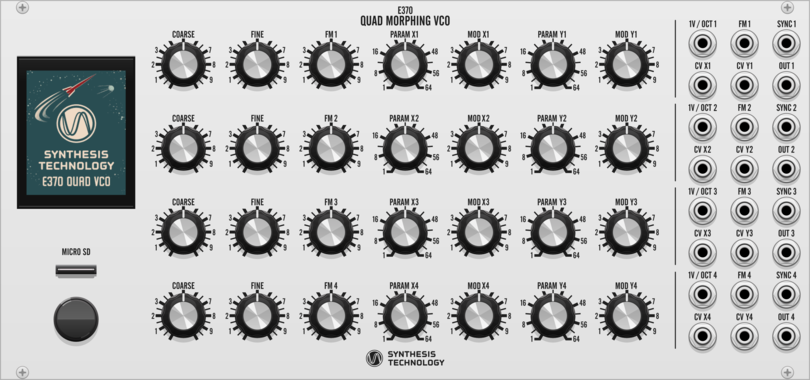I didn’t mention, but E352 and E370 are now available in VCV Rack !!! !!! !!!!!!!
Am I a little excited? Um, maybe.
!!!
As I have probably said quite some time ago in this blog, I was an early adopter of the E352, and then beta tester #1 for the E370. Paul Schreiber (RIP) shipped me a beta test unit (which literally said “beta test unit” on the front panel) to beat on back in September 2017, for about 10 days before I shipped it to fellow bald ambient synthesist Robert Rich, and then after other beta testers and a demo at Control in NYC, it got sent back to me. After a while I eventually traded it back to the simpler and smaller E352, and then eventually that and my Hertz Donut were replaced by Shapeshifter. But SynthTech’s wavetable oscillators still have a place in my heart, so I’m quite happy to have it again in virtual form.

I thought I was going to prefer the E352 in VCV Rack, since I can spawn as many instances of it as I want. But where the 352 has 3 dedicated CV inputs, and different modes depending on which parameters you want to control with them, the 370 has fewer modes but a total of 8 assignable CV inputs, and I just found that a bit more to my liking. Also having four oscillators in one module encourages modulation, stacking etc. which makes the thing shine even more.
Also, Dawesome, makers of some really creative synth designs, have announced a new one. Kontrast, a wavetable synth that apparently scans 2D maps using all kinds of nonlinear patterns…
Digital oscillators typically use a lookup table. Feed it a rising sawtooth wave of exactly the right min/max values, look up a stored data value and output that. Wavetable synthesis (invented by Max Matthews in 1958) uses a 2D array, so you have time in one dimension and timbral morphing in another.
I’m not sure if Paul’s E350 was the first to do this, but you can also add another dimension and have two parameters to smoothly morph the timbre. This has become a popular feature in Eurorack modules.
Some oscillators have used a sort of 2D topographical map, scanning over it in patterns to produce the output. (Starling’s Via Scanner was one of those, but it was a bit obscure and tricky to use.) Kontrast is taking this approach, but with an excellent UI and some really novel looking ways to form paths… almost approaching the strange attractors etc. in Dawesome Kult. A really simple map but complex paths is potentially a lot more interesting in terms of modulating parameters, than a really simple path with a complex but static wavetable.
In harder news, the city/county/whatever is finally fixing the hole in the street that’s been there since the wall builders caused the gas leak back in April. (Honestly, I half expected it to go through the entire winter before getting fixed.) I haven’t looked to see if they also are dealing with the sidewalk, or if it’s just the street.
